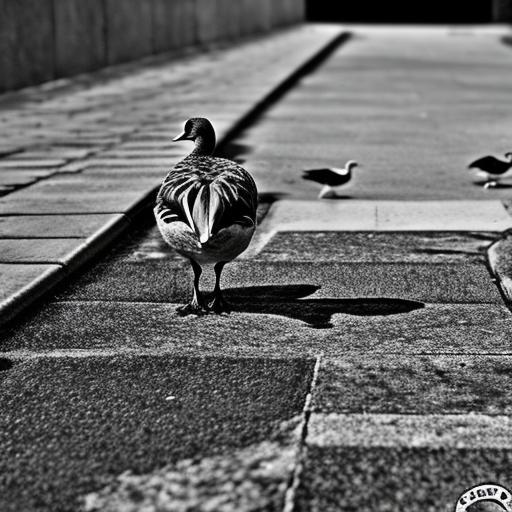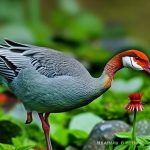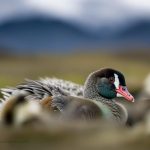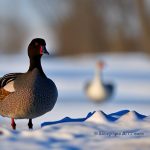Geese are beautiful and majestic creatures that are often found near bodies of water, such as ponds, lakes, and rivers. While they are a sight to behold, they can also be a nuisance when they leave their droppings on sidewalks and pathways. Geese droppings are not only unsightly, but they can also pose health risks to humans. The droppings can contain harmful bacteria such as E. coli and salmonella, which can cause illnesses if they come into contact with humans. Additionally, the droppings can make walking on sidewalks and pathways unpleasant and even hazardous, as they can be slippery and difficult to clean.
Geese are also known to be territorial creatures, and they may become aggressive when they feel threatened or when they are protecting their nests. This can pose a danger to pedestrians who are simply trying to navigate their way through public spaces. Furthermore, the presence of geese and their droppings can deter people from using these public areas, which can have a negative impact on the community as a whole. Therefore, it is important to find effective and humane ways to deter geese from congregating in these areas and leaving their droppings behind.
Geese are migratory birds that often travel in large flocks, making it difficult to control their movements. They are also protected under the Migratory Bird Treaty Act, which means that any efforts to deter them must be done in a way that does not harm the birds or their nests. This presents a challenge for property owners and community members who are dealing with the issue of geese and their droppings. However, with the right approach and the use of appropriate methods, it is possible to address this problem effectively and ethically.
Key Takeaways
- Geese droppings can pose health and safety hazards, making it important to address the issue.
- Physical barriers such as fences and hedges can effectively deter geese from congregating in unwanted areas.
- Natural repellents like citrus sprays and predator decoys can discourage geese from settling in specific locations.
- Creating a welcoming environment for geese in alternative areas can help redirect their presence away from sidewalks and public spaces.
- Regular maintenance and cleaning of sidewalks is crucial in deterring geese and maintaining a safe environment.
- Seeking professional help from wildlife control experts can provide effective and humane solutions for deterring geese.
- It is important to consider the legal and ethical implications of deterring geese, and to ensure that any methods used are in compliance with local regulations and animal welfare standards.
Implementing physical barriers to deter geese
One effective way to deter geese from congregating on sidewalks and pathways is to implement physical barriers that prevent them from accessing these areas. This can include installing fences, hedges, or other structures that create a boundary between the geese and the public spaces. These barriers should be tall enough to prevent the geese from flying over them, and they should also be sturdy enough to withstand the birds’ attempts to break through them.
Another option is to use visual deterrents such as scarecrows or predator decoys that mimic natural predators of geese, such as coyotes or foxes. These visual deterrents can create a sense of danger for the geese, causing them to avoid the area altogether. Additionally, reflective objects such as shiny tape or balloons can be used to disorient the geese and discourage them from landing in these spaces.
It is important to note that any physical barriers or visual deterrents used to deter geese must be implemented in a way that does not harm the birds or their nests. It is crucial to adhere to the guidelines set forth by the Migratory Bird Treaty Act and other wildlife protection laws when implementing these measures. By using physical barriers and visual deterrents in a responsible and ethical manner, it is possible to create a safe and pleasant environment for pedestrians while also deterring geese from leaving their droppings in these public spaces.
Using natural repellents to discourage geese
In addition to physical barriers and visual deterrents, natural repellents can also be used to discourage geese from congregating on sidewalks and pathways. One common natural repellent is the use of plants that are unappealing to geese, such as tall grasses or shrubs with thorns. These plants can create an inhospitable environment for geese, causing them to seek out more welcoming areas for feeding and nesting.
Another natural repellent is the use of certain scents that are unpleasant to geese. For example, the scent of grape extract has been found to be effective in deterring geese from certain areas. By applying this extract to the surrounding vegetation or using it in spray form, it is possible to create an environment that is unattractive to geese without causing harm to the birds or the surrounding ecosystem.
It is important to note that natural repellents should be used in a way that is safe for the environment and other wildlife. Care should be taken to avoid using any substances that could be harmful to other animals or plants in the area. Additionally, it is important to regularly assess the effectiveness of natural repellents and make adjustments as needed to ensure that they continue to deter geese from congregating in these public spaces.
By using natural repellents in conjunction with physical barriers and visual deterrents, it is possible to create a comprehensive approach to deterring geese from leaving their droppings on sidewalks and pathways. This multi-faceted approach can help create a safe and welcoming environment for pedestrians while also respecting the needs of the geese and other wildlife in the area.
Creating a welcoming environment for geese elsewhere
While it is important to deter geese from congregating on sidewalks and pathways, it is also important to provide alternative spaces where they can thrive without posing a nuisance to humans. Creating a welcoming environment for geese elsewhere can help redirect their activities away from public spaces while still allowing them to flourish in their natural habitat.
One way to create a welcoming environment for geese elsewhere is to designate specific areas near bodies of water where they can feed and nest without coming into direct contact with pedestrians. These areas can be equipped with features that are attractive to geese, such as grassy banks, shallow water, and natural vegetation. By providing these designated spaces, it is possible to encourage geese to congregate in areas where they are less likely to leave their droppings on sidewalks and pathways.
Another option is to work with local wildlife organizations or conservation groups to identify suitable habitats for geese in the surrounding area. By collaborating with these organizations, it is possible to develop strategies for managing geese populations in a way that is beneficial for both the birds and the community. This can include creating protected areas where geese can thrive without posing a nuisance to humans, as well as implementing measures to ensure that their natural habitats remain intact and free from disturbances.
By creating a welcoming environment for geese elsewhere, it is possible to strike a balance between deterring them from public spaces while still allowing them to thrive in their natural habitat. This approach can help minimize conflicts between humans and geese while also promoting coexistence and harmony between the two species.
Consistent maintenance and cleaning of the sidewalk
In addition to implementing deterrents and creating alternative spaces for geese, consistent maintenance and cleaning of sidewalks and pathways is essential for addressing the issue of geese droppings. Regular cleaning of these public spaces can help remove any droppings that may have accumulated, making them safe and pleasant for pedestrians to use.
One way to maintain clean sidewalks is by regularly sweeping or power washing the surfaces to remove any droppings or debris left behind by geese. This can help prevent the buildup of droppings over time, making it easier to keep these public spaces clean and inviting for pedestrians.
It is also important to address any underlying issues that may be attracting geese to these areas in the first place. This can include removing sources of food or water that may be attracting the birds, as well as making changes to the surrounding landscape to make it less appealing for nesting or feeding.
By consistently maintaining and cleaning sidewalks and pathways, it is possible to create an environment that is unattractive to geese while also ensuring that these public spaces remain safe and enjoyable for pedestrians. This proactive approach can help minimize the impact of geese droppings on public spaces while also promoting a clean and welcoming environment for everyone in the community.
Seeking professional help to address the issue
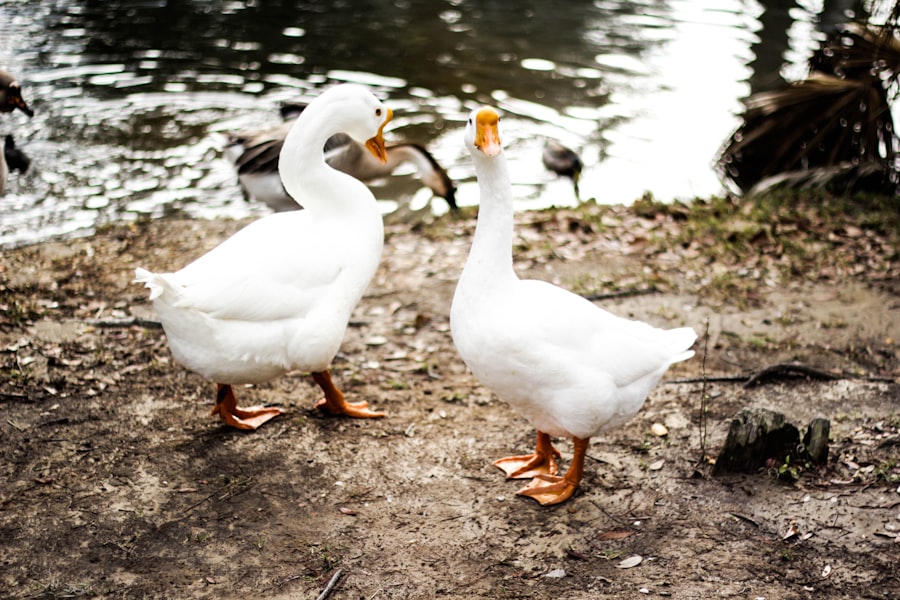
In some cases, addressing the issue of geese droppings may require professional assistance from wildlife experts or pest control professionals. These professionals have the knowledge and experience necessary to develop effective strategies for deterring geese from public spaces while also ensuring that their needs are met in a humane and ethical manner.
One option is to work with wildlife experts who specialize in managing bird populations in urban environments. These experts can assess the situation and develop customized solutions for deterring geese from congregating on sidewalks and pathways. This may include implementing habitat modifications, using non-lethal deterrents, or developing long-term management plans for addressing the issue.
Pest control professionals can also provide valuable assistance in addressing the issue of geese droppings. They have access to a range of tools and techniques that can be used to deter geese from public spaces without causing harm to the birds or the surrounding environment. By working with these professionals, it is possible to develop effective strategies for managing geese populations while also promoting coexistence between humans and wildlife.
By seeking professional help to address the issue of geese droppings, it is possible to access specialized knowledge and resources that can help develop effective solutions for managing this problem. This collaborative approach can help ensure that the needs of both humans and geese are met in a way that promotes harmony and coexistence between the two species.
Understanding the legal and ethical considerations of deterring geese
When addressing the issue of geese droppings, it is important to consider the legal and ethical implications of deterring these birds from public spaces. Geese are protected under the Migratory Bird Treaty Act, which means that any efforts to deter them must be done in a way that does not harm the birds or their nests.
It is crucial to adhere to all relevant wildlife protection laws when implementing deterrents or management strategies for geese populations. This includes obtaining any necessary permits or approvals before taking action, as well as ensuring that all measures are carried out in a way that minimizes harm to the birds and their natural habitats.
Additionally, it is important to consider the ethical implications of deterring geese from public spaces. While it is important to create safe and pleasant environments for pedestrians, it is also important to respect the needs of wildlife and promote coexistence between humans and animals. This may involve finding ways to deter geese from public spaces while still providing alternative habitats where they can thrive without posing a nuisance to humans.
By understanding the legal and ethical considerations of deterring geese, it is possible to develop strategies that are effective, humane, and respectful of wildlife protection laws. This approach can help promote coexistence between humans and geese while also addressing the issue of droppings in public spaces in a responsible manner.
In conclusion, addressing the issue of geese droppings on sidewalks and pathways requires a multi-faceted approach that takes into account the needs of both humans and wildlife. By understanding the behavior of geese and implementing physical barriers, natural repellents, and consistent maintenance strategies, it is possible to create safe and welcoming environments for pedestrians while also deterring geese from leaving their droppings behind. Seeking professional help when necessary and understanding the legal and ethical considerations of deterring geese are essential components of this approach. By taking these factors into consideration, it is possible to address the issue of geese droppings in a way that promotes coexistence between humans and wildlife while also creating clean and inviting public spaces for everyone in the community.
If you’re looking for ways to keep geese from pooping on your sidewalk, you might also be interested in learning about the best flooring options for a chicken coop. Check out this informative article on choosing the right flooring for your chicken coop to ensure a clean and comfortable environment for your feathered friends.
Meet Walter, the feathered-friend fanatic of Florida! Nestled in the sunshine state, Walter struts through life with his feathered companions, clucking his way to happiness. With a coop that’s fancier than a five-star hotel, he’s the Don Juan of the chicken world. When he’s not teaching his hens to do the cha-cha, you’ll find him in a heated debate with his prized rooster, Sir Clucks-a-Lot. Walter’s poultry passion is no yolk; he’s the sunny-side-up guy you never knew you needed in your flock of friends!

